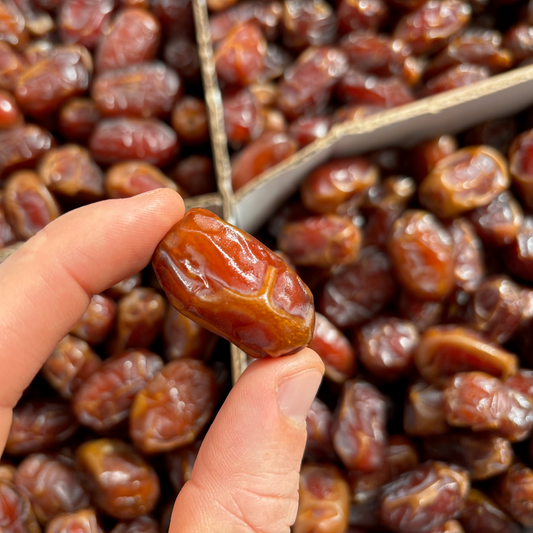Fresh this week
Murray Family Farms is often one of the first farms with organic cherries in California, but growing cherries in the southern San Joaquin Valley is only getting harder. To properly set fruit, fruit trees require a certain number of chill hours, or time during the tree’s winter dormancy where temperatures are below 45°F. A good winter chill is especially important for cherries, which require some of the most chill hours to produce a good crop, somewhere in the 700-800 hour range. In just the last decade, the Murray family has seen eight of the warmest winters they’ve ever had on their farm. South of Bakersfield, Stephen Murray experiments with different crops and varieties that can accommodate a warming climate. The OB1 cherry is one of them. ("OB1" is the geneticist's shorthand; the Murrays have re-named it OB1-Kinobi :) It has deep, dark purple skin, soft sweet flesh, and it requires fewer chill hours, making it a good fit for the area now and hopefully well into the future. This spring, the Murrays’ OB1 cherry orchard is producing a sizable harvest for the first time since they planted it several years ago. It’s a new variety for them and for the cherry market. Tastes like a winner! Enjoy these dark cherry beauties. Store in the fridge. Grown organically by Murray Family Farm in Bakersfield.
Don’t blink or you might miss mulberry season! These purple Pakistan mulberries from Habitera Farms are extremely lovable. They’re juicy, they taste like berry jam, and the whole thing is edible! I think the soft center stem adds a nice bite of texture when you’re munching on them. We visited farmers Luis and Jorge right as the season was starting up to see how the orchard was looking. (This may be world-altering but yes, mulberries are botanically trees. They are often pruned and shaped into shrubs because, left to their own devices, they can get up to 60 feet tall!) These mulberries are a real labor of love. Jorge has five decades of experience working in fruit orchards, and his pruning and shaping of the trees is art. At harvest, nets are rolled through the orchard to catch the ripe fruit that falls as the crew shakes the tree’s branches. And then the post-harvest handling of these delicate little morsels requires even more care. Eat ’em quick. They won’t (and shouldn’t) last long. Store in the fridge. Grown sustainably by Habitera Farms in Brentwood. (Habitera will be fully CCOF certified organic at the end of 2025. For more on the transition to organics, read on.)
We brought in one of our favorite versions of the Albion strawberry from Dirty Girl Produce this week for a little strawberry varietal tasting! These Albions are from Dirty Girl’s second-year plants. Second-year plants produce smaller berries and fewer berries per plant, but maximum flavor. Albions have this classic strawberry essence. The texture is quite firm, a notable contrast to the softness of the Chandler from Swanton Berry Farm. Dirty Girl grows a handful of other varieties, such as Montereys, Fronteras, and Seascapes, but the Albion is a reliable early producer for them. As the weather along the coast starts to become more consistent, we’re hoping to see more volume with other varieties so we can continue the tasting throughout the summer! Store in the fridge. Grown organically by Dirty Girl Produce in Watsonville.
We say goodbye to the beloved Snowchasers from Coastal Moon and welcome the short, short window of Jewel blueberry harvest. The season has now started up in most blueberry-growing regions of California so they are all over the markets. Jewel blues are super sweet with very little acid, and the flavor is incredibly delicious. Coastal Moon has fewer Jewel plants which makes it a shorter season than the other varieties. This ephemerality makes them taste even better. It’s dangerously easy to eat these by the handful. Is there such a thing as eating too many blues? Store in the fridge. Grown organically by Coastal Moon in Freedom.
Terra Firma Farm’s red grapefruit is something we anticipate all year long, even as citrus season begins to feel like a slog. They only begin to harvest their Ruby Red grapefruit in April. It’s a special late-season grapefruit; a class of its own! By late spring, they're deliciously sweet-tart, super juicy, and full of flavor flavor flavor! Store on the counter. Grown organically by Terra Firma Farm in Winters.
The Murcott mandarin is a variety that’s grown all around the world. It’s often labeled “Honey tangerine” for its sweet, honeyed flavor mellowed by a nice orange-y tang. Any mandarin that’s been hanging on the trees this late into the season is going to have extremely high sugars. Jose Luis Melendez and David Scheuring of Gold Oak Ranch just finished their last mandarin harvest of the season. Harvesting late-season mandarins can be tricky because the top of the mandarin, where it attaches to the stem, often starts to dry out. Lucky for us, these Murcotts are still super juicy and incredibly tasty. The weather has been heating up in the Capay Valley so enjoy these last mandarins from that region. Grown organically by Gold Oak Ranch in Esparto.
Encore appearances
Swanton Berry Farm’s Chandler strawberries!! This feels incredibly momentous – we’ve made it to another strawberry season! Jim Cochran has been growing strawberries organically for nearly 40 years and he grows our FAVORITE version: the sweet, tender, juicy, Chandler strawberry. These are first year plants which means these baby plant starts were put in the ground in the fall of 2023 and are now producing. First year plants typically produce larger berries and are abundant in yield! Store in the fridge. Grown organically by Swanton Berry Farm in Davenport.





